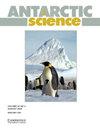1911-1912 年南极运行期间罗斯冰架的极端降水事件
IF 2
4区 地球科学
Q3 ENVIRONMENTAL SCIENCES
引用次数: 0
摘要
1912 年 3 月,罗伯特-法尔孔-斯科特船长和他的同伴们在从南极返回的途中丧生。最后的暴风雪给了他们致命一击。然而,这只是这个耐力与悲剧故事的一部分。1911 年 12 月,在前往南极点的途中,由于异常温暖潮湿的暴风雪,这些人在帐篷中困了 4 天。本文将极地考察队在 1911 年 12 月遇到的气象情况与现代的类似情况进行了比较,并提出了 1911 年事件背后可能的气候学原理。本文章由计算机程序翻译,如有差异,请以英文原文为准。
Extreme precipitation event at the Ross Ice Shelf during the 1911–1912 South Pole run
In March 1912, Captain Robert Falcon Scott and his companions perished on their return journey from the South Pole. The Final Blizzard delivered a terminal blow. However, it was only a part of this story of endurance and tragedy. In December 1911, en route to the South Pole, the men had been tent-bound for 4 days due to an exceptionally warm, wet blizzard. This article compares the meteorological situation that the polar party encountered in December 1911 to a similar situation in the modern time and suggests a possible climatology behind the 1911 event.
求助全文
通过发布文献求助,成功后即可免费获取论文全文。
去求助
来源期刊

Antarctic Science
地学-地球科学综合
CiteScore
3.60
自引率
6.20%
发文量
42
审稿时长
3 months
期刊介绍:
Antarctic Science provides a truly international forum for the broad spread of studies that increasingly characterise scientific research in the Antarctic. Whilst emphasising interdisciplinary work, the journal publishes papers from environmental management to biodiversity, from volcanoes to icebergs, and from oceanography to the upper atmosphere. No other journal covers such a wide range of Antarctic scientific studies. The journal attracts papers from all countries currently undertaking Antarctic research. It publishes both review and data papers with no limits on length, two-page short notes on technical developments and recent discoveries, and book reviews. These, together with an editorial discussing broader aspects of science, provide a rich and varied mixture of items to interest researchers in all areas of science. There are no page charges, or charges for colour, to authors publishing in the Journal. One issue each year is normally devoted to a specific theme or papers from a major meeting.
 求助内容:
求助内容: 应助结果提醒方式:
应助结果提醒方式:


